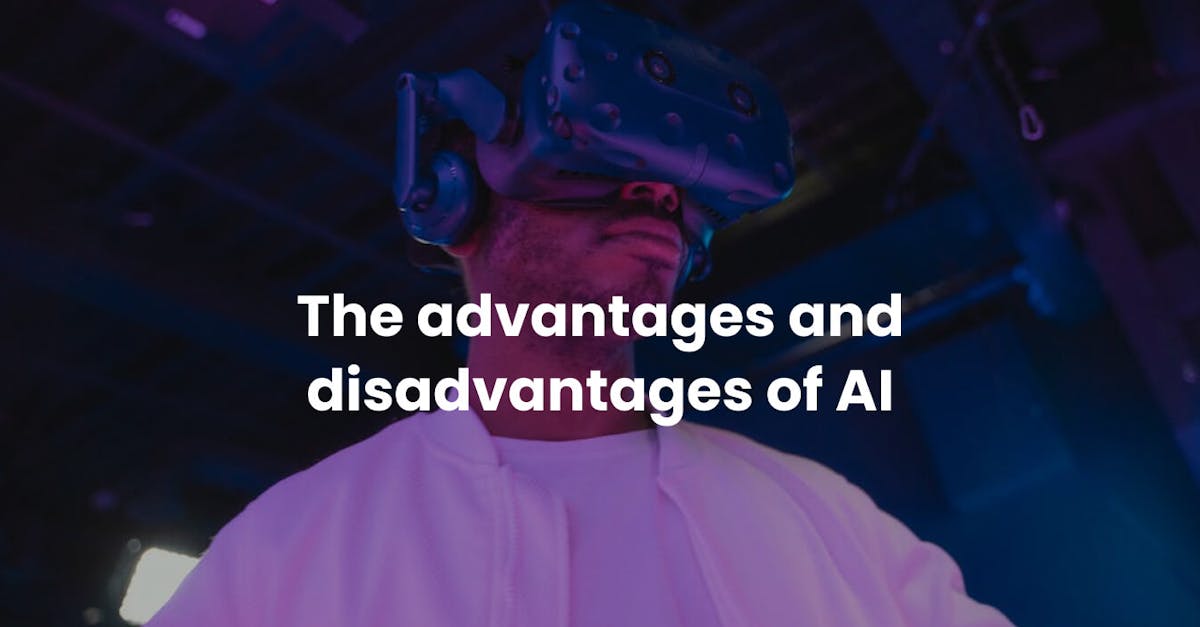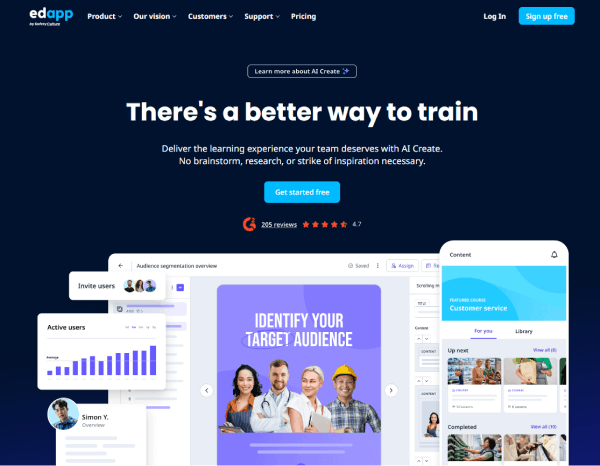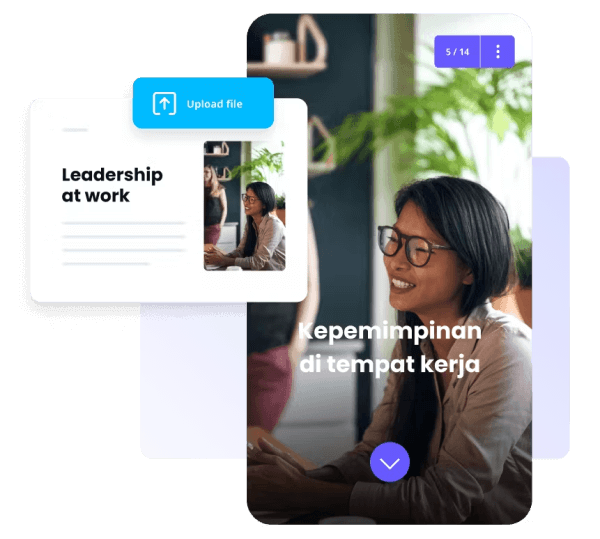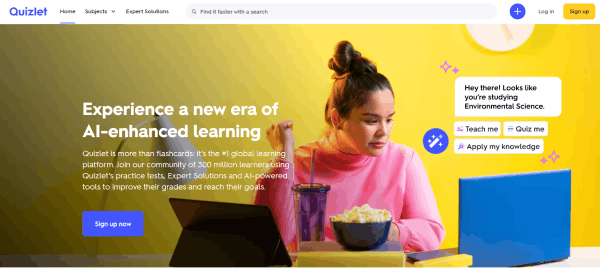The advantages and disadvantages of AI: A guide for trainers

Artificial intelligence (AI) has made a significant impact on various industries, including training. AI-powered training solutions bring a host of benefits, such as personalized learning experiences, improved efficiency, and cost-effectiveness. But, like any technology, AI in training has its disadvantages, too.
In this article, we'll explore the advantages and disadvantages of AI in training and discuss how it can revolutionize the way we learn and train people. But before we delve into all of these, let's first explore the definition of artificial intelligence, or AI.
What is Artificial Intelligence?
AI involves creating machines that can simulate human intelligence. These machines can learn, reason, and perform tasks that typically require human intelligence. Essentially, AI allows computer systems to analyze vast amounts of data, identify patterns, and make decisions or predictions.

Advantages of AI in Training
Now that we understand what AI is all about, let's move on to the benefits of AI in training.

Personalized learning
One of the significant advantages of AI in training is its ability to create and deliver personalized learning experiences.
AI algorithms can analyze how each person is doing, what they like, and how they learn best. Then, it can adjust training materials and activities to suit each learner's needs. This personalized approach enhances engagement and knowledge retention, as learners receive content that aligns with their specific needs.
Adaptive learning paths
AI-powered training platforms can help you deliver an adaptive learning experience to your team. These tools can check what your learners are good at and where they need help, and recommend the right content and activities to fill the gaps and improve learning outcomes. This means learners get exactly what they need to learn, grow, and improve in their role.
Smart content creation
AI can make creating training materials a breeze. It can read and analyze loads of information in seconds, filter relevant content, and present it in a structured manner. This feature saves you incredible time and effort so that you can focus on more strategic aspects of your training.
Enhanced engagement
AI brings advanced technologies like virtual reality (VR) and augmented reality (AR) into the mix, making learning more fun and engaging. Learners get to try out their tasks in realistic settings and see the outcomes of their actions. Not only does it help boost your team’s learning engagement, but it also improves their retention.
Continuous assessment and feedback
AI can automate the process of assessing learner performance and giving them real-time feedback. By looking at data, AI can see how learners are progressing, point out where they can do better, and give personalized feedback. This continuous assessment helps learners stay motivated, identify their strengths and weaknesses, and make necessary adjustments to their learning strategies.
Boost learner engagement with EdApp's AI-driven features. Experience adaptive learning paths, real-time feedback, and interactive experiences that captivate and empower your learners.
Disadvantages of AI in training
It’s important to acknowledge that while AI in training offers numerous advantages, it is not without its challenges.

Here are some of the disadvantages that you may encounter when using AI in your training:
Reduced human interaction
While AI can offer personalized learning experiences, it can’t replicate the depth and richness of human interaction. Direct human-to-human communication gives emotional support, empathy, and nuanced understanding, which can be crucial in certain training contexts.
Technical glitches and dependency
AI systems aren't foolproof. Just like any other advanced tool, it can also face technical glitches or malfunctions. In training scenarios, technical issues can disrupt the learning process and cause frustration among learners.
Additionally, relying too much on AI may create a dependency on technology, making it difficult to switch back to traditional methods if needed.
Privacy and data security concerns
AI in training involves collecting and analyzing a huge amount of learner data. This raises concerns about privacy and data security. Organizations need to have strong measures in place to protect sensitive learner information from unauthorized access or breaches.
5 Tips to make the most of AI in training
In this section, we’ll unpack some expert tips on how you can maximize the benefits of AI in training while addressing its potential disadvantages.

1. Emphasize Blended Learning
Balance AI-driven content with human interaction to create a well-rounded training experience. Incorporate opportunities for your learners to engage with their trainers, mentors, or peers through discussions, group activities, or live sessions.
2. Prioritize data security
It’s also important to protect your learners’ data by implementing strong security measures. Make sure that your organization remains in compliance with data protection regulations and encrypts sensitive information. It’s also important that you and your team use secure servers and implement access controls to safeguard learner information. It’s also important that you and your team use secure servers hosted in a sustainable data center and implement access controls to safeguard learner information.
3. Maximize AI for efficiency, but maintain human expertise
It’s always great to use AI to automate repetitive tasks, analyze data, and create content. But you also need to recognize the value of human trainers and subject matter experts who bring unique insights and contextual understanding to enhance your team’s training experience.
4. Foster autonomous learning
Encourage learners to take ownership of their learning journey. Give them opportunities for self-assessment, goal setting, and self-paced learning. While AI can recommend personalized learning paths, make sure that you are still empowering them to explore additional resources, ask questions, and seek clarification beyond AI suggestions.
5. Continuously evaluate and adapt
Regularly assess the effectiveness of AI-powered training programs. Analyze learner feedback, performance data, and learning outcomes to identify areas for improvement. Use this information to improve AI algorithms, update content, and adapt the training approach to better meet your learners' needs.
Top artificial Intelligence learning apps to boost your training
Apart from understanding the advantages and disadvantages of AI in training, exploring the top AI-powered learning apps can take your training initiatives to the next level. These apps make the most use of AI technology to deliver personalized and engaging learning experiences.
Let's take a look at some of the AI-powered new technology in 2023 that you can use to boost your training outcomes:
1. EdApp
EdApp is an excellent example of an AI-powered learning app that combines the advantages of AI with a user-friendly interface.

One standout feature is the AI Create tool, which allows you to get an entire training course ready in just a minute. Gone are the days of spending countless hours brainstorming and researching. This AI tool already streamlines the content creation process, so you can focus more on delivering impactful training experiences.

Another noteworthy feature of EdApp is its AI translation tool, which employs Google's Machine Learning Cloud Translation Engine. With just a few clicks, you can convert your courses into more than 100 other languages. This powerful feature opens up opportunities for global training initiatives, allowing learners from diverse linguistic backgrounds to access and benefit from your training content.

Streamline your content creation process with EdApp's AI Create. Skip the brainstorming and research stage and dive straight into creating interactive training today!
Sign up for free.
2. ChatGPT
ChatGPT can be used in various ways to enhance the training experience for your teams. It can serve as a knowledge repository, where you can find instant answers to common questions or information on specific topics. Or, you can use it to create a training outline or supplement training materials for your learners.

You can also employ ChatGPT to offer instant feedback on assignments, assessments, or any training exercises. It can analyze responses, identify areas for improvement, and offer constructive feedback for better learning experiences.
3. Quizlet
Quizlet is an AI-powered study app that helps learners gain expertise in certain subject areas through flashcards, quizzes, and games. You can use its AI features to create personalized study plans, generate adaptive quizzes, and offer instant feedback on learners' progress. What’s more is that Quizlet's interactive and gamified approach makes learning engaging and effective, which is a great boost to your team’s training journey.

Conclusion: Balancing the advantages and disadvantages of AI
Using AI in training has many benefits, like personalized learning, adaptable learning paths, and smart content selection. It also improves engagement and offers continuous assessment and feedback. But it's important to recognize that there are challenges also, like potential lack of human interaction, technical issues, and privacy concerns.
Even though AI enhances the learning process, it shouldn't replace the value of human connection and expertise. The best approach is to find a balance between the pros and cons of AI, and combine the strengths of both AI and human trainers, creating a more impactful training experience.
To make the most of the advantages and disadvantages of AI in your training, you can use advanced apps like EdApp, ChatGPT, and Quizlet. These applications allow the integration of AI for delivering personalized, engaging, and effective training programs. By using these AI tools, you can improve the overall learning experience of your team and achieve better training outcomes.
Author
Jen Avelino
Jen is a learning expert at SC Training (formerly EdApp), a mobile-based training platform that helps corporates and businesses bring their training solutions to the next level. She carries an extensive writing experience in a variety of fields, including architecture, the gig economy, and computer software. Outside of work, she enjoys her free time watching her favorite series and documentaries, reading motivational books, and cross-stitching.
